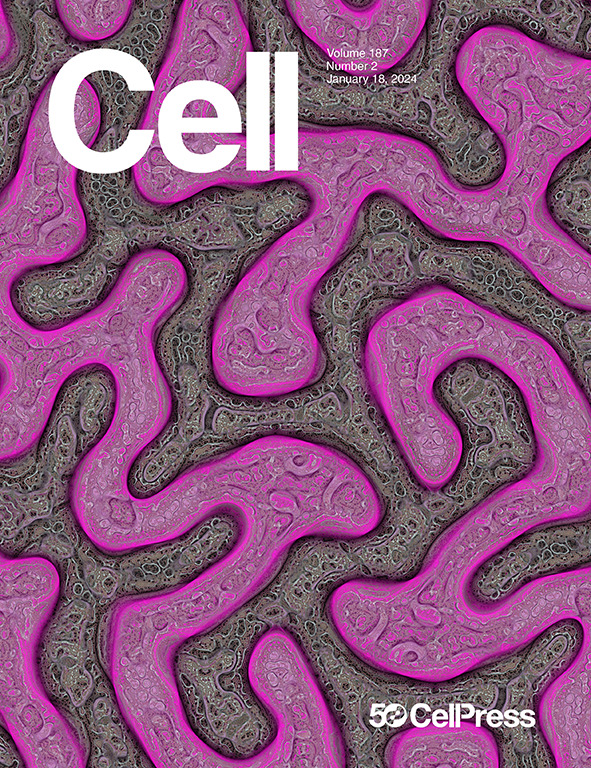Autoimmune mechanisms elucidated through muscle acetylcholine receptor structures
IF 45.5
1区 生物学
Q1 BIOCHEMISTRY & MOLECULAR BIOLOGY
引用次数: 0
Abstract
Skeletal muscle contraction is triggered by acetylcholine (ACh) binding to its ionotropic receptors (AChRs) at neuromuscular junctions. In myasthenia gravis (MG), autoantibodies target AChRs, disrupting neurotransmission and causing muscle weakness. While treatments exist, variable patient responses suggest pathogenic heterogeneity. Progress in understanding the molecular basis of MG has been limited by the absence of structures of intact human muscle AChRs. Here, we present high-resolution cryoelectron microscopy (cryo-EM) structures of the human adult AChR in different functional states. Using six MG patient-derived monoclonal antibodies, we mapped distinct epitopes involved in diverse pathogenic mechanisms, including receptor blockade, internalization, and complement activation. Electrophysiological and binding assays revealed how these autoantibodies directly inhibit AChR channel activation. These findings provide critical insights into MG immunopathogenesis, uncovering unrecognized antibody epitope diversity and modes of receptor inhibition, and provide a framework for developing personalized therapies targeting antibody-mediated autoimmune disorders.

通过肌肉乙酰胆碱受体结构阐明自身免疫机制
骨骼肌收缩是由乙酰胆碱(ACh)与神经肌肉接头处的离子受体(AChRs)结合引发的。在重症肌无力(MG)中,自身抗体以 AChRs 为靶点,破坏神经传递并导致肌肉无力。虽然存在治疗方法,但患者的反应各不相同,这表明病因存在异质性。由于缺乏完整的人类肌肉 AChRs 结构,人们对 MG 分子基础的了解一直受到限制。在这里,我们展示了人类成人 AChR 在不同功能状态下的高分辨率冷冻电镜(cryo-EM)结构。通过使用六种源自 MG 患者的单克隆抗体,我们绘制了涉及不同致病机制的不同表位,包括受体阻断、内化和补体激活。电生理学和结合试验揭示了这些自身抗体是如何直接抑制 AChR 通道激活的。这些发现提供了对 MG 免疫发病机制的重要见解,揭示了尚未认识到的抗体表位多样性和受体抑制模式,并为开发针对抗体介导的自身免疫性疾病的个性化疗法提供了框架。
本文章由计算机程序翻译,如有差异,请以英文原文为准。
求助全文
约1分钟内获得全文
求助全文
来源期刊

Cell
生物-生化与分子生物学
CiteScore
110.00
自引率
0.80%
发文量
396
审稿时长
2 months
期刊介绍:
Cells is an international, peer-reviewed, open access journal that focuses on cell biology, molecular biology, and biophysics. It is affiliated with several societies, including the Spanish Society for Biochemistry and Molecular Biology (SEBBM), Nordic Autophagy Society (NAS), Spanish Society of Hematology and Hemotherapy (SEHH), and Society for Regenerative Medicine (Russian Federation) (RPO).
The journal publishes research findings of significant importance in various areas of experimental biology, such as cell biology, molecular biology, neuroscience, immunology, virology, microbiology, cancer, human genetics, systems biology, signaling, and disease mechanisms and therapeutics. The primary criterion for considering papers is whether the results contribute to significant conceptual advances or raise thought-provoking questions and hypotheses related to interesting and important biological inquiries.
In addition to primary research articles presented in four formats, Cells also features review and opinion articles in its "leading edge" section, discussing recent research advancements and topics of interest to its wide readership.
 求助内容:
求助内容: 应助结果提醒方式:
应助结果提醒方式:


